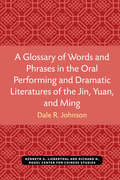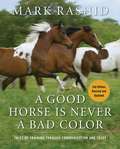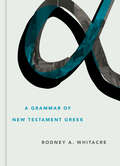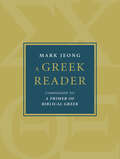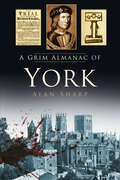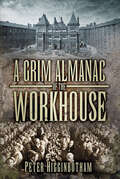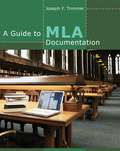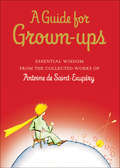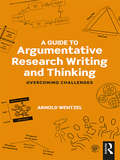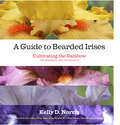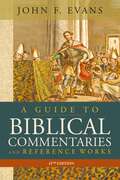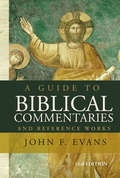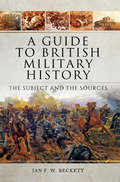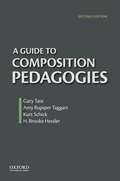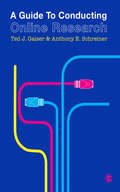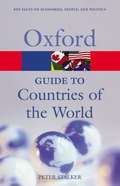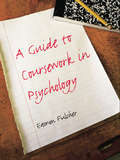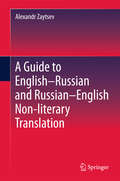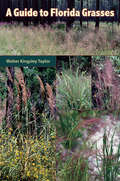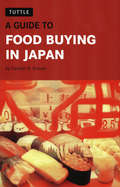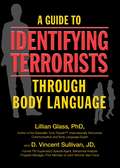- Table View
- List View
A Glossary of Literary Terms
by M. H. Abrams Geoffrey Galt HarphamThis book defines and discusses terms, critical theories, and points of view that are commonly applied in classifying, analyzing, interpreting, and writing the history of works of literature. The component entries, together with the guides to further reading included in most of them, are oriented especially toward undergraduate students of English, American, and other literatures. Over the decades, however, the book has proved to be a useful and popular work of reference for advanced students, as well as for the general reader with literary interests.
A Glossary of Words and Phrases in the Oral Performing and Dramatic Literatures of the Jin, Yuan, and Ming (Michigan Monographs In Chinese Studies #89)
by Dale R. JohnsonFor many years, the oral performing and dramatic literatures of China from 1200 to 1600 CE were considered some of the most difficult texts in the Chinese corpus. They included ballad medleys, comic farces, Yuan music dramas, Ming music dramas, and the novel Shuihu zhuan. The Japanese scholars who first dedicated themselves to study these works in the mid-twentieth century were considered daring. As late as 1981, no comprehensive dictionary or glossary for this literature existed in any language, Asian or Western. A Glossary of Words and Phrases fills this gap for Western readers, allowing even a relative novice who has resonable command of Chinese to read, translate, and appreciate this great body of literature with an ease undreamed of even two decades ago. The Glossary is organized into approximately 8,000 entries based on the reading notes and glosses found in various dictionaries, thesauruses, glossaries, and editions of works from the period. Main entries are listed alphabetically in the pinyin romanization system. In addition to glosses, entries include symbolic annotations, guides to pronunciation, and text citations. The result is a broadly useful glossary serving the needs of students of this literature as well as scholars researching Jin and Yuan language and its usage.
A Good Horse Is Never a Bad Color: Tales of Training through Communication and Trust
by Mark RashidIn A Good Horse Is Never a Bad Color, Mark Rashid continues to share his talent for training horses through communication rather than force. Rashid uses humorous, feel-good stories to relate his techniques of teaching horses by examining their view of the world. These stories deal with many aspects of buying, owning, and training horses with a special focus on those that are troubled and hard-to-train. The arrested development of horses like these, Rashid shows, is often a result of their trainers’ own lack of understanding of their unique psychologies. With stories that stress the importance of patience and understanding, this book is a must-have for compassionate horse trainers and owners. Tales of Arabs, appaloosas, and paints—mistrusted and mistreated because of their breed—will give readers a new perspective on these breeds and others. Sometimes, it’s the attitude that needs to be fixed rather than the horse. Rashid’s accounts of horses bound for slaughter because they were considered impossible to train will inspire you to give your own problem horse a second look. This new edition features added introductory notes for each chapter that contribute to a better understanding of Rashid’s philosophy and methods.
A Grammar of New Testament Greek (Eerdmans Language Resources)
by Rodney A. WhitacreA reader&’s guide to the morphology and syntax of Koine Greek From the pen of a seasoned instructor of biblical Greek, this book functions as both an essential resource for second-year students and an invaluable asset for all readers as they continue to hone and deepen their linguistic skills. It begins with a basic overview of the language for new learners and for those looking for a brief refresher before moving into nuanced matters of morphology and syntax. Whitacre&’s aim is ultimately to help readers understand the subtleties of the language on the pages of the New Testament; thus, he engages with the biblical text both grammatically and exegetically, so that readers can experience its full power and beauty. Including numerous illustrative examples throughout and several useful appendices at the end, A Grammar of New Testament Greek is indispensable both as a textbook and as a reference for all readers of the Greek New Testament—and other texts written in Koine, such as the Septuagint and the Apostolic Fathers.
A Graphic History of Sport: An Illustrated Chronicle of the Greatest Wins, Misses, and Matchups from the Games We Love
by Andrew JanikEvery sport has its legends . . . THE RUMBLE IN THE JUNGLE THE BATTLE OF THE SEXES THE PINE TAR INCIDENT THE STEEL CURTAIN PHI SLAMA JAMA A Graphic History of Sport presents artist Andrew Janik’s survey of the weird and wonderful world of athletic competition. The unforgettable plays and over-the-top personalities, the heated rivalries and storied dynasties— all come to vivid life in a series of illustrations filled with subtle wit and a modern design aesthetic. Each illustration is paired with a detailed historic overview as well as surprising stats and trivia, capturing a true sports fan’s delight in the games we love to love and the players we love to hate.
A Greek Reader: Companion to A Primer of Biblical Greek (Eerdmans Language Resources)
by Mark JeongA companion resource for use with N. Clayton Croy&’s Primer of Biblical Greek, featuring dozens of simple, enjoyable narratives to reinforce the content and skills introduced by Croy. Too often, Greek readers include difficult primary texts encumbered with glosses, but this reader from Mark Jeong is instead comprised of originally written texts keyed to the vocabulary and grammar taught in Clayton Croy&’s Primer of Biblical Greek. Thus fluent, comprehensive reading—rather than painstaking translation—can be the goal. In addition to providing useful practice, Jeong&’s engaging narratives will help students of Greek grasp the nuances of particularly complicated aspects of Koine—such as the imperfect tense—by allowing them to see the language &“in action&” in various textual situations. Each narrative also follows a larger story about the adventures of Philemon, Onesimus, and Paul, making for enjoyable reading that better prepares one for the daunting task of eventually reading the Greek New Testament.
A Grim Almanac of York
by Alan SharpThis day-by-day account of gruesome tales from York’s past reveals the seedy underbelly of what was historically the most important city in the North. Inside these pages you will find true stories of murder and intrigue, battles and conspiracies, witches and religious martyrs, gruesome executions and horrible accidents. Read about Margaret Clitherow, tortured to death for her beliefs, Richard Scrope, the archbishop executed for treason, and of course the notorious highwayman Richard ‘Dick’ Turpin and his moonlight ride. If you have ever wondered what nasty goings-on occurred in the York of yesteryear, then read on … if you dare!
A Grim Almanac of the Workhouse (Grim Almanacs)
by Peter HigginbothamFor two centuries, the shadow of the workhouse hung over Britain. The recourse of only the most desperate, dark and terrible tales of malnutrition, misery, mistreatment and murder ran like wildfire through the poorer classes, who lived in terror of being forced inside the institution’s towering walls. This book contains 365 incredible tales of fires, drownings, explosions and disasters, infamous scandals such as the Andover affair – where inmates were forced to eat the bones they were supposed to be crushing to ward off starvation – and sickening tales of abuse, assault, bodysnatching, poisonings, post mortems and murder. Accompanied by 70 rare and wonderful illustrations, this book will thrill, fascinate, sadden and unnerve in equal measure.DID YOU KNOW?In the early hours of 31 August 1888, the mutilated body of Mary Ann Nichols – the first generally accepted victim of Jack the Ripper – was discovered in Buck’s Row, Whitechapel, just a little way from the Whitechapel workhouse infirmary. Nichols, aged forty-two at her death, had been a regular habituée of London’s workhouses.On 30 May 1896, at the age of seven, future Hollywood star Charlie Chaplin entered the Newington workhouse in south London, together with his mother, Hannah, and his older half-brother Sydney.On 19 March 1834 a revolt took place amongst the juvenile female paupers of St Margaret’s workhouse, Westminster. A young man named Speed, appointed as their superintendent, provoked their wrath by his alleged tyrannical behaviour. He was unmercifully thrashed by the girls who tore his clothes nearly off his back and beat him until his cries raised the alarm and the police were sent for to quell the disturbance.
A Guide To MLA Documentation (Ninth Edition)
by Joseph F. TrimmerBriefer, more affordable, and easier to use than the MLA's own handbook, this popular booklet features current MLA guidelines, a new section on evaluating online sources, and an up-to-date APA appendix. The guide also provides numerous examples, a sample research paper, and helpful hints on such topics as avoiding plagiarism and taking notes.
A Guide for Grown-ups: Essential Wisdom from the Collected Works of Antoine de Saint-Exupéry (The\little Prince Ser.)
by Antoine de Saint-ExupéryA delightful collection of inspiring quotations from the mind of Antoine de Saint- Exupéry, author of The Little Prince.&“One sees clearly only with the heart. Anything essential is invisible to the eyes.&”For more than sixty years, this insight from The Little Prince has been quoted in more than 130 languages by fans around the world. Now, for the first time, quotations from the collected works and letters of Antoine de Saint-Exupéry are presented in a charming gift edition. Six chapters—&“Happiness,&” &“Friendship,&” &“Responsibility,&” &“Fortitude,&” &“Love,&” and &“What Is Essential&”—offer inspirational and thought-provoking words about the subjects held most dear by the author. A perfect gift for graduates—or for anyone who wants gentle guidance.
A Guide for the Statistically Perplexed
by David L. Streiner Canadian Psychiatric AssociationDo statistics-heavy research papers give you a headache? Are you baffled by bias, confused by correlation, or flummoxed by F-tests? A Guide for the Statistically Perplexed is here to help! This book is designed to assist students, clinicians, and researchers in becoming familiar with statistical and research techniques by covering the essentials of the topic and drawing attention to many common problem areas.Inspired to write on this topic in reaction to mistakes he encountered in actual papers, David L. Streiner uses his trademark sense of humour and light-hearted style to explain complex statistical concepts in lucid, jargon-free language. Streiner delves into topics such as presenting data (or, conversely, how not to), statistical techniques, and more advanced procedures. To help readers detect problems with research design and interpretation, he details important 'CRAP' (convoluted reasoning or anti-intellectual pomposity) detectors for which they should watch out.Even those with little or no background in statistics, measurement theory, or research will come out of A Guide for the Statistically Perplexed with a new understanding and appreciation of these topics.
A Guide to Argumentative Research Writing and Thinking: Overcoming Challenges
by Arnold WentzelResearch is difficult. Even though students are trained in the basic research methodology skills, when confronted with research writing, it feels to them as if they enter a bizarre world, with its own language and conventions, where it is hard to get things right. This book translates the apparent complexities of research writing into everyday ideas, language and skills, and will enable novice researchers to start overcoming the major stumbling blocks immediately. This book focuses only on the greatest challenges in research writing, specifically those that supervisors find most difficult to explain to novice researchers. These challenges include both basic and more complex skills, such as: finding original research contributions; establishing one’s voice while drawing on other authors; turning a vague idea into a feasible research question; generating literature reviews that are original in themselves; and avoiding list-like writing when discussing the research methodology. Wentzel shows that it is easier to overcome these challenges, not with lists of prescriptions that are difficult to remember while writing, but rather by cultivating an argumentative mindset. Not only is such a mindset much easier to maintain, but it offers a central point around which one can organise any difficult writing task. The book shows how to use the argumentative mindset to approach every important writing challenge. It translates all the necessary skills into jargon-free language using a variety of visuals and simple step-by-step procedures that will enable any person to read the book quickly and start writing immediately. The book is accompanied by a website containing an instructor’s manual with guidance on the teaching and assessment of research writing, as well as lecture slides.
A Guide to Bearded Irises: Cultivating the Rainbow for Beginners and Enthusiasts
by Kelly NorrisThe diversity of bearded irises rivals that of any other perennial grown in temperate climates. For some gardeners, they bring back warm memories of a grandparent's garden; for others, they're a cutting-edge plant with a seemingly endless capacity for producing new forms and patterns.As the manager of Rainbow Iris Farm and co-editor of the Bulletin of the American Iris Society, Kelly Norris is the authority on gardening with bearded irises. His introductory chapters offer tips for successful growth, garden design, plant selection, and "creating" new irises. A Guide to Bearded Irises also provides portraits of the most outstanding plants in each of the six recognized categories, from the dainty miniature dwarf bearded irises to the stately tall bearded irises. A resource section lists specialty nurseries, organizations devoted to bearded irises, and public gardens with notable iris collections.
A Guide to Biblical Commentaries and Reference Works, 11th Edition
by John F. EvansA Guide to Biblical Commentaries and Reference Works, 11th Edition by John F. Evans, summarizes and briefly analyzes all recent and many older commentaries on each book of the Bible, giving insightful comments on the approach of each commentary and its usefulness for biblical interpretation. The easy-to-use book provides analysis in canonical order and includes helpful appendices for compiling a personal research library. A Guide to Biblical Commentaries and Reference Works, 11th Edition, is a key reference tool for any student of the Bible--pastors, laity, and scholars alike.
A Guide to Biblical Commentaries and Reference Works: 10th Edition
by John F. EvansA Guide to Biblical Commentaries and Reference Works, by John F. Evans, summarizes and briefly analyzes all recent and many older commentaries on each book of the Bible, giving insightful comments on the approach of each commentary and its interpretive usefulness especially for evangelical interpreters of the Bible. A Guide to Biblical Commentaries and Reference Works is essentially an annotated bibliography of hundreds of commentators. More scholarly books receive a longer, more detailed treatment than do lay commentaries, and highly recommended commentaries have their author’s names in bold. The author keeps up on the publication of commentaries and intends to update this book every three to four years.
A Guide to British Military History: The Subject and the Sources
by Ian F. BeckettWhat exactly is military history? Forty years ago it meant battles, campaigns, great commanders, drums and trumpets. It was largely the preserve of military professionals and was used to support national history and nationalism. Now, though, the study of war has been transformed by the war and society approach, by the examination of identity, memory and gender, and a less Euro-centric and more global perspective. Generally it is recognised that war and conflict must be integrated into the wider narrative of historical development, and this is why Ian Becketts research guide is such a useful tool for anyone working in this growing field. It introduces students to all the key debates, issues and resources. While European and global perspectives are not neglected, there is an emphasis on the British experience of war since 1500. This survey of British military history will be essential reading and reference for anyone who has a professional or amateur interest in the subject, and it will be a valuable introduction for newcomers to it.
A Guide to Composition Pedagogies, Second Edition
by Gary Tate H. Brooke Hessler Amy Rupiper-Taggart Kurt SchickA Guide to Composition Pedagogies is the essential bibliographic guide written for newcomers to the field. Since our field has evolved quite a lot over the last decade, this long-awaited second edition contains many important changes, additions, and updates. At the same time, the practical organization and educational intent of the book have remained the same: The pedagogies themselves are categories commonly recognized in the disciplinary scholarship, and as with the first edition, each essay introduces the most important work in the field on the pedagogy, while attempting to offer readers a sense of the spirit of the approach, often through personal teaching narratives. t In short, this best-selling bibliographic guide familiarizes writing instructors with the current topography of Composition Studies and directs them to the best books and articles for further exploration. For this second edition, each author discusses some of the implications of technology for each pedagogy. In addition, the essays now focus more on practice and slightly less on theory.
A Guide to Conducting Online Research
by Ted J Gaiser Anthony E SchreinerA Guide to Conducting Online Research is designed to support students, academics and research practitioners in using technology to conduct their research. The book begins by looking at what questions to ask and how to prepare to conduct online research, then concentrates on particular technologies and how to employ them effectively, before concluding with a discussion of the peculiarities of conducting research in the online environment. Practical advice is offered on common issues and problems, such as: - How to decide which application is best for your research purposes? - What can be done to guarantee the anonymity of research participants? - What kinds of challenges do firewalls present and how can they be mitigated? A Guide to Conducting Online Research provides a wealth of advice, explanation, instruction, self-help tips and examples, making this a helpful resource for anyone using technology in conducting their research.
A Guide to Countries of the World (Revised Second Edition)
by Peter StalkerThe new edition of this invaluable reference work has been painstakingly updated and revised to feature the very latest information in an overview of each country in the world. Up-to-date maps and vital statistics are included for every country. Double-page spreads provide maps and geographical details along side concise overviews of the social, economic, and political issues shaping each country. Global Data tables show social and economic indicators such as GNP, life expectancy, and population growth/density of each country side by side for easy comparison. In today's world changes in geography and demography can have serious short and long-term international implications. No reference work will keep you as up-to-date on the countries of the world as Oxford's latest Guide.
A Guide to Coursework in Psychology
by Eamon FulcherEver had difficulty choosing a research project? Ever wondered how your work will be marked? This book will help students to understand the coursework specifications and marking criteria for a number of key exam boards, including; AQA (specification A and B), OCR, EDEXCEL and SQA. It provides specific and highly relevant advice on how to maximise achievement in coursework. Guidance is offered on how best to choose a research project, through to practical advice on how to carry out research and write up reports. Topics to be avoided are also considered and advice on how to navigate the difficulties and avoid common pitfalls provided. Key issues covered include: * An overview of the main methods of investigation in psychology * Data analysis, including how to present data in Word and Excel and how best to comment on it * How to draw conclusions from data and create inferential statistics. Incorporating a series of examples, including an investigation from start to finish, and a laboratory experiment, this book provides clear, hands-on advice. It will be an invaluable tool for GCSE, AS and A2 students, helping them to maintain their motivation through coursework assignments and to achieve their potential.
A Guide to English-Russian and Russian-English Non-literary Translation
by Alexandr ZaytsevLying at the intersection of translatology, cognitive science and linguistics, this brief provides a comprehensive framework for studying, investigating and teaching English-Russian/Russian-English non-literary translation. It provides a holistic perspective on the process of non-literary translation, illustrating each of its steps with carefully analyzed real-life examples. Readers will learn how to choose and process multidimensional attention units in original texts by activating different types of knowledge, as well as how to effectively devise target-language matches for them using various translation techniques. It is rounded out with handy and feasible recommendations on the structure and content of an undergraduate course in translation. The abundance of examples makes it suitable not only for use in the classroom, but also for independent study.
A Guide to Essential Human Services (2nd edition)
by Frederic G. ReamerThis book provides useful information on local, state, and government assistance programs and is beneficial to social workers, social work educators, and agencies providing services to individuals which include health care services, addictions, sexual orientation, family life education, children and adolescents, military personnel and veterans, immigrants and refugees, education and literacy, employment assistance, and legal services and dispute resolution, etc.
A Guide to Florida Grasses
by Walter Kingsley TaylorA Guide to Florida Grasses offers an introduction to this vital and frequently neglected plant family. This richly illustrated reference includes complete details pertaining to the identification, structure, distribution, and uses of more than 200 of the most common grasses found in Florida and nearby states. With over 500 color images--some picturing species that have never been described with a published image--correctly identifying and selecting members of this important plant family has never been easier. Environmentalists, hikers, and nature lovers can take this book into the field or enjoy it at home. A Guide to Florida Grasses will be accessible and invaluable to professional botanists, commercial landscapers, homeowners, and plant enthusiasts alike.
A Guide to Food Buying in Japan
by Carolyn R. KrouseNewly arrivals in Japan are usually pleasantly surprised at the wide variety of food products available in local markets but then find it difficult to recognize items and to read labels. This guide takes the mystery out of shopping for food in Japan. The first part of the book outlines what the shopper will encounter when buying food in Japan, including Japanese writing, the different kinds of markets, and the methods of pricing and labeling food products. The second part describes different types of products, when and where they can be found, and how they can be incorporated into daily menus. Four appendixes, a vocabulary list, and an index complete this handy volume.
A Guide to Identifying Terrorists Through Body Language
by Lillian Glass D. Vincent Sullivan JDIt's not just Osama Bin Laden anymore.It's the people all around you - from coworkers to your next-door neighbor. From domestic terrorists and serial killers to troubled students and homicidal exes, violent people are living right here among us. But we don't have to count on patience and providence to get us through. In A Guide to Identifying Terrorists Through Body Language, renowned body-language expert and bestselling Toxic People author Dr. Lillian Glass reveals the visual cues, characteristics, and behaviors we need to identify the most dangerous people in our midst - in only seconds. In this book she teams up with former FBI Special Agent D. Vincent Sullivan where they both draw upon decades of experience. Her expertise in body language, vocal forensics, and behavioral analysis, and his experience as a former member of the Joint Terrorist Task Force provide you with the the same instruction, information, and insight they have provided to law enforcement, the justice system, and Homeland Security, among others. Complete with real-life scenarios and case studies, this groundbreaking handbook is the protection we upstanding citizens need to keep ourselves, our families, and our society free from harm.

